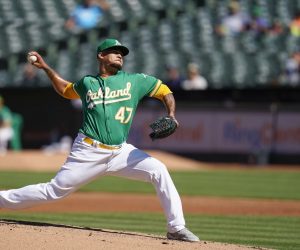On one misty day in June 1970, Dock Ellis pitched a no-hitter for the Pittsburgh Pirates against the San Diego Padres while soaring high on lysergic acid diethylamide (LSD). It’s a rare feat to toss a no-no, but the fact that Ellis had ingested LSD the morning before the game made his legendary no-hitter one of the craziest moments in sports over the last 50 years.

“It was the first and only no-hitter of the career of Dock Ellis, and almost certainly the lone MLB no-hitter pitched under the influence of LSD,” Sports Illustrated reported.
Starting pitchers only played every fifth day and had more downtime than the rest of their teammates. In the case of Ellis, he ingested LSD on his day off, but lost time during a psychedelic bender.
As the story goes, the Pittsburgh Pirates were on a West Coast road trip when Ellis stopped off in Los Angeles to visit old friends. He ate LSD and partied it up in LA until a lady friend woke him up to go to work.
“I pitch tomorrow,” said Ellis in a documentary by No Mas Productions. “Because I had gotten up in the middle of the morning and took more acid.”
She showed him the sports section in the local newspaper, which said Ellis had been slated to take the mound that day against the San Diego Padres. While still tripping balls on LSD, Ellis headed to San Diego to go to work and the rest, as they say, is history.
Ellis ate speed to help take the edge off, reduce hallucinations, and help him focus on the mound. He walked eight and hit another batsman during an erratic nine innings, but managed to complete a no-hitter against the Padres.
MLB and the History of Drugs
Baseball has had a long-standing relationship with pharmaceutical-grade and street-level drugs. Before World War II, amphetamines started appearing in clubhouses, but they weren’t widespread until after the war. Many ballplayers were hard boozers, and even Joe DiMaggio smoked cigarettes in the dugout. Players occasionally relied on pep pills to wake up for a day game during a grueling 154-game season in which they traveled by trains and played weekly doubleheaders.
After WWII, the majority of players relied on various amphetamines. Many were introduced to Dexedrine or “Go Pills” during military service. They didn’t think twice about ingesting speed to enhance their performance on the field.
Every clubhouse and some benches had bowls filled with greenies (Dexedrine) and reds, nicknames derived from the color of the pill. When the league shifted to night games and away from day games, speed usage actually increased. Once you jump on the speed train, it’s impossible to get off.
Some clubhouses spiked the coffee with greenies and they offered two pots of coffee: normal and speed-induced.
Greenies were legal for more than 70 years until MLB banned amphetamines in 2006. Your favorite ballplayers ingesting speed had become the worst-kept secret in the big leagues.
Lucy in the Sky with Diamonds
By the time the late-1960s arrived, a vast array of drugs, including marijuana, hashish, and psychedelics blew open the doors to the clubhouse. As the counterculture swept through America, younger athletes grew out their hair and turned on to recreational drugs.
Professional athletes were on the polar opposite of the spectrum. Many coaches instilled military-like discipline, but turned a blind eye to boozing, painkiller abuse, or popping speed pills. Younger athletes, much like hippies protesting the Vietnam war, called out the establishment for their hypocrisy.
Ellis came to age during the era of hippiedom. He didn’t think twice about LSD and other mind-altering substances. But most of the experimenters waited until after their games to get down.
During the legendary LSD no-hitter tale, Ellis partied so hard that he forgot what day it was. But he’s a true professional and got his space together before taking the mound. Ellis (138-119 lifetime record) tossed the only no-hitter of his 12-year career, albeit on LSD.
Say No to Drugs, but Yes to Steroids?
By the start of the 1980s, baseball developed a severe cocaine problem behind the scenes. Players would toot up between innings to maintain their edge. Members of the St. Louis Cardinals only slid headfirst into bases because they didn’t want to break the cocaine vial in their back pockets.
After the harsh anti-drug messages of the Reagan administration and the “Just Say No” campaign, many pro leagues including both MLB and the NBA cleaned up their image to weed out the cokeheads.
With pro sports starting to reap big bucks with lucrative television and cable deals, the game got even more competitive. That’s when players began to experiment with steroids. By the end of the 1990s, baseball had become overrun with players taking PEDs.
Many baseball purists wanted asterisks added to the record books (e.g., Barry Bonds, Mark McGwire, Roger Clemens) because all of the new record holders had been notorious steroid users. Even to this day, both Clemens and Bonds have yet to make it into the Hall of Fame because baseball writers refuse to vote any of the “Roid Boys” into Cooperstown.











